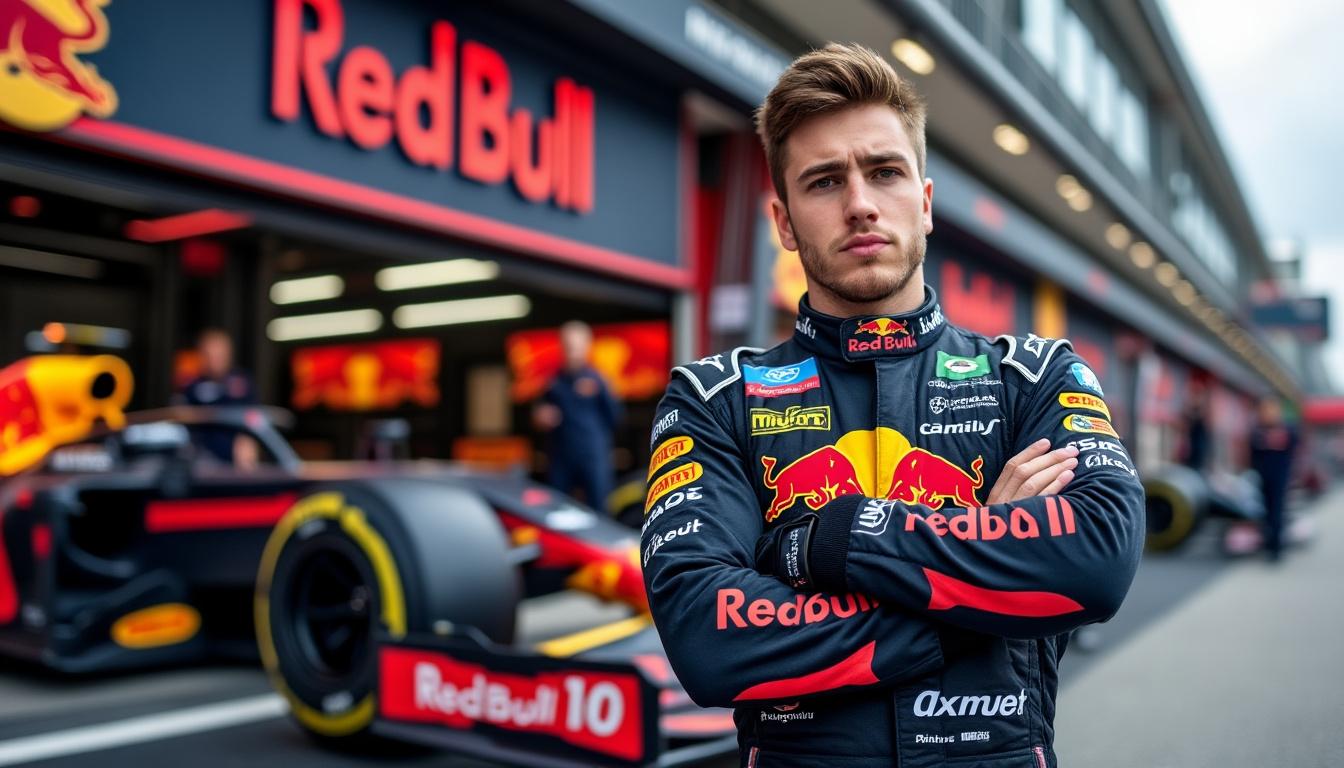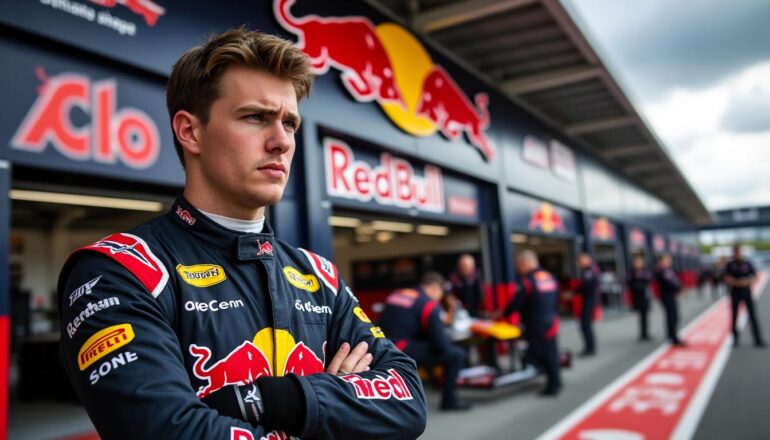As the thrilling gears of Formula 1 continue to turn, the spotlight shines on Red Bull’s driver lineup.
With each passing race, speculations arise about who will stay and who might exit the prestigious team.
Amidst this frenzy, F1 pundit Jamie Chadwick has stirred the pot with hints of potential shake-ups.
The driver dynamics at Red Bull are at a crucial juncture, with whispers of impending changes echoing through the paddock. Chadwick has signaled that both Liam Lawson and Yuki Tsunoda could face the prospect of being sidelined as the team vies for a driver who can keep pace with the formidable Max Verstappen. After a brief stint, Lawson found himself replaced by Tsunoda, who is currently grappling with his own challenges on the track. Meanwhile, Isack Hadjar is emerging as a strong candidate for 2026, boasting a promising rookie season that has captured Red Bull’s attention. Yet, Chadwick cautions that being successful in the junior team doesn’t guarantee a smooth transition to the Red Bull seat, emphasizing the importance of consistency and performance under pressure. With the upcoming season on the horizon, the quest to unearth the next racing prodigy intensifies, reminding us of the relentless ambition that drives Red Bull’s search for excellence.

As the search for the next standout driver in the world of Formula 1 continues, Liam Lawson, a promising talent from Red Bull’s junior team, shares his thoughts about the pressures that accompany the coveted F1 seat. Lawson, who made a brief appearance with the Red Bull team earlier in the season, highlights the precarious position many drivers find themselves in when vying for a permanent place in such a high-stakes environment. His brief stint with the team has put him in a unique position to reflect on the ongoing competition and the risks that potential new drivers face.
With Max Verstappen establishing a new benchmark for excellence, any driver stepping into Red Bull is expected to perform at an elite level. This escalated pressure can be daunting. A driver’s opportunity might hinge not just on individual *abilities* but also on the team’s need to regularly evaluate talent against Verstappen’s performance. Lawson recalls the pressure during his tenure, stating, “You understand that performance is crucial, but there’s also the worry about whether you’ll fit into the team’s broader goals.”
Moreover, Lawson emphasizes the winding road from junior categories to F1. His promotion to Red Bull even after competing successfully in various junior series is a testament to how talent alone doesn’t guarantee success. During his initial races, Lawson faced immediate pressure. “One or two poor performances can have profound implications,” he explains, recognizing the thin margin for error in F1 racing.
Coupled with the pressures of performance are the internal team dynamics and external competition. Face competition from peers like Yuki Tsunoda and rising stars such as Isack Hadjar adds another layer of complexity to Lawson’s experience. “It’s a fast-paced world where you constantly have to be at your best, not only to secure your seat but also for your future career,” he stresses.
What does it take to become Red Bull’s next star?
The journey to becoming Red Bull’s next superstar driver is not as straightforward as it seems. The team’s relentless search for a driver who can emulate Verstappen’s dominance requires both skill and the synergy to thrive within a team. Red Bull’s aspirations mean they are now scrutinizing any new driver’s history, potential, and adaptability critically.
Lawson points out that it’s not merely about raw speed; a burgeoning talent must also showcase a consistent ability to develop with the car and respond positively to feedback. “Red Bull has a specific culture,” he notes. “They want a driver who fits into that mold – someone who not only thinks about themselves but also how they can uplift the team.”
This insight echoes the concerns voiced by F1 pundits such as Jamie Chadwick, who recently suggested that both Lawson and Tsunoda might be at risk as Red Bull examines all potential candidates. Chadwick highlights that the team is not just interested in producing competent drivers. They are hunting for the next marquee talent in the likes of Verstappen, a driver who can challenge and potentially surpass existing performance metrics.
With up-and-coming talents like Arvid Lindblad, who is linked to a possible promotion to F1, the competition for seats becomes even fiercer. “Every new driver represents a potential threat to those already in the car,” Lawson warns, as he competes with a growing roster of skilled contenders.
This tense environment fosters the need for a robust mental framework. For Lawson, maintaining composure amidst the pressure is essential. Yet, he acknowledges that it can be hard to detach emotionally from performance reviews, feedback, and public expectations.
What are the implications of the inherent risks?
The risks associated with stepping into a Red Bull seat extend beyond the race track. For many drivers, securing a permanent seat entails substantial personal and professional risks. Becoming an F1 driver is often viewed as achieving a dream, but Lawson points out the realities of being discarded if you don’t meet expectations.
“The consequences of falling short can impact a driver’s career long-term,” he states. Drivers who do not deliver have often found themselves relegated to lower tiers or pushed to seek opportunities elsewhere – a fate that could jeopardize years of hard work and aspirations. The F1 landscape is littered with examples of talented individuals who failed to capitalize on their opportunities and subsequently vanished from the grid.
Lawson elaborates on this precarious situation as he notes the pressure surrounds not only performance but also sponsorship opportunities. The backing of sponsors and the media can be exhilarating yet comes weighted with demands. “You have to not only drive but also manage your media presence,” he reflects. “The perception of who you are off the track can be just as pivotal as your driving skills in it.”
Understanding and navigating these obstacles is essential for any driver aiming for excellence in the fast-paced realm of F1. The ability to cultivate a positive relationship with the media, sponsors, and the team can play a significant role in a driver’s longevity and prosperity within the sport.
How can the next generation of drivers succeed despite the challenges?
Despite the myriad challenges facing aspiring F1 drivers, Lawson expresses a sense of optimism regarding the next generation. He believes that the key to success involves a combination of exceptional skill, mental resilience, and a well-rounded approach to growth. Young drivers must focus on mastering not only their driving abilities but also the soft skills necessary for fostering strong relationships within the team environment.
“Coming into F1, you’re not just a driver; you’re an ambassador for the brand,” Lawson articulates. “Developing your visibility and connection with fans is essential alongside pushing your limits on the circuit.” It’s a holistic process that blends technical prowess with strong communication skills, working closely with engineers, and ultimately, shaping a driver’s public persona.
Additionally, embracing technology and analytics has become increasingly critical. Understanding data gathering, simulation work, and feedback mechanisms allow drivers to improve rapidly. “In today’s world, drivers have access to extensive data analytics,” Lawson mentions. “Using that to your advantage can make a distinct difference in your trajectory.”
Moreover, aspiring drivers can draw lessons from Red Bull’s successful pipeline system, which meticulously cultivates young talent from various racing backgrounds. This approach has been successful even when navigating through recent challenges, proving that despite the risks, success is still achievable. Through a combination of resilience, adaptability, and unyielding ambition, Lawson underscores that the next generation can aspire to find their place in F1, even as the stakes continue to rise.
In summary, the world of Formula 1 is as exhilarating as it is challenging, and for drivers like Liam Lawson, the stakes continue to climb. With the spotlight on Red Bull to find a successor to Max Verstappen, aspiring drivers face an uphill battle filled with both risks and opportunities that could dictate the next chapter in their racing careers.


